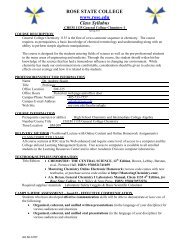Chapter 18
Chapter 18
Chapter 18
You also want an ePaper? Increase the reach of your titles
YUMPU automatically turns print PDFs into web optimized ePapers that Google loves.
<strong>18</strong>-1
<strong>Chapter</strong><br />
<strong>18</strong><br />
Creating and Managing Change<br />
McGraw-Hill/Irwin<br />
Management, 7/e<br />
Copyright © 2007 The McGraw-Hill Companies, Inc. All rights reserved.
<strong>18</strong>-3<br />
Learning Objectives<br />
After Studying <strong>Chapter</strong> <strong>18</strong>, You will know<br />
What it takes to be world class<br />
How to manage change effectively<br />
How to create a successful future
Managing Change<br />
<strong>18</strong>-4
<strong>18</strong>-5<br />
Becoming World Class<br />
Managers today want, or should want, their<br />
organizations to become world class<br />
To some this may seem like a lofty, impossible,<br />
unnecessary goal but it is a goal that is<br />
essential to survival and success in today’s<br />
intensely competitive business world<br />
Being world class requires applying the best and<br />
latest knowledge and ideas, and having the ability<br />
to operate at the highest standards of anyplace<br />
anywhere<br />
World-class companies create high-value products<br />
and earn superior profits over the long run
<strong>18</strong>-6<br />
Sustainable, Great Futures<br />
Over the years world-class companies have<br />
been widely admired, been considered the<br />
premier institutions in their industries, and<br />
made a real impact on the world<br />
World class companies also<br />
Turn in extraordinary performance over the long run<br />
Have strong core values in which they believe deeply; and<br />
they express and live the values consistently<br />
They do not focus on beating the competition; the focus<br />
primarily on beating themselves<br />
Great companies have core values, know<br />
what they are and what they mean, and live<br />
by them – year after year
Sustainable, Great Futures<br />
<strong>18</strong>-7
<strong>18</strong>-8<br />
The Tyranny of the ‘Or’<br />
Many companies, and individuals, are plagued<br />
by the tyranny of the or<br />
This refers to the belief that things must be<br />
either A or B, and cannot be both<br />
Examples include<br />
Choose to either change or remain stable<br />
Be conservative or bold<br />
Have control and consistency or creative<br />
freedom
<strong>18</strong>-9<br />
The Genius of the ‘And’<br />
Organizational ambidexterity; genius of the ‘and’<br />
refers to the ability to achieve multiple things<br />
simultaneously<br />
Purpose beyond profit and pragmatic pursuit of<br />
profit<br />
Relatively fixed core values and vigorous change<br />
and movement<br />
Conservatism with the core values and bold<br />
business moves<br />
Clear vision and direction and experimentation<br />
Long-term thinking and investment and demand<br />
for short-term results<br />
Visionary, futuristic thinking and daily, nuts-andbolts<br />
execution
<strong>18</strong>-10<br />
Organization Development<br />
Organization development is a system wide<br />
application of behavioral science knowledge to<br />
develop, improve, and reinforce the strategies,<br />
structures, and processes that lead to<br />
organization effectiveness<br />
It improves the organization’s ability to respond to<br />
external groups like customers, stockholders,<br />
governments, employees, and other stakeholders<br />
It has an important underlying value orientation –<br />
it supports human potential, development, and<br />
participation in addition to performance and<br />
competitive advantage
<strong>18</strong>-11<br />
Achieving Greatness<br />
Three are four key factors to achieving greatness<br />
Strategy – focused on customers, continually fine-tuned<br />
based on marketplace changes, and clearly<br />
communicated to employees<br />
Execution – good people, with decision-making<br />
authority on the front lines, doing quality work and<br />
cutting costs<br />
Culture – one that motivates, empowers people to<br />
innovate, rewards people appropriately, entails strong<br />
values, challenges people<br />
Structure – making the organization easy to work in and<br />
easy to work with, characterized by cooperation and the<br />
exchange of information and knowledge throughout the<br />
organization
<strong>18</strong>-12<br />
Managing Change<br />
Shared leadership is crucial to the success of<br />
most change efforts<br />
People must be not just supporters of change<br />
they also need to be implementers<br />
There needs to be a permanent rekindling of<br />
individual creativity and responsibility, a true<br />
change in the behavior of people throughout the<br />
organization<br />
The essential task is to motivate people fully to<br />
keep changing in response to new business<br />
challenges
<strong>18</strong>-13<br />
Motivating People to Change<br />
People must be motivated to change<br />
Managers tend to underestimate the amount of<br />
resistance they will encounter<br />
Some general for resistance include:<br />
Inertia – people don’t want to disturb the status<br />
quo<br />
Timing<br />
Surprise<br />
Peer pressure
<strong>18</strong>-14<br />
Motivating People to Change<br />
Some change-specific reasons for resistance<br />
include<br />
Self-interest<br />
Misunderstanding<br />
Different assessments<br />
Management tactics
Motivating People to Change<br />
<strong>18</strong>-15
<strong>18</strong>-16<br />
A General Model for Managing Resistance<br />
Motivating people to change often requires<br />
three basic stages<br />
Unfreezing<br />
Moving<br />
Refreezing
<strong>18</strong>-17<br />
Specific Approaches to Enlist Cooperation<br />
Most managers underestimate the variety of<br />
ways they can influence people during a<br />
period of change<br />
Some effective approaches include<br />
Education and communication<br />
Participation and involvement<br />
Facilitation and support<br />
Negotiation and rewards<br />
Manipulation and cooptation<br />
Explicit and implicit coercion
Specific Approaches to Enlist<br />
Cooperation<br />
<strong>18</strong>-<strong>18</strong>
<strong>18</strong>-19<br />
Harmonizing Multiple Changes<br />
Total organization change involves<br />
introducing and sustaining multiple policies,<br />
practices, and procedures across multiple<br />
units and levels<br />
Total organizational changes can<br />
Affect the thinking and behavior of everyone in<br />
the organization<br />
Enhance the organization’s culture and<br />
success<br />
Be sustained over time
<strong>18</strong>-20<br />
Leading Change<br />
Successful change<br />
requires managers to<br />
actively lead it<br />
Leaders must start by<br />
examining the current<br />
realities facing the<br />
organization<br />
From here they can<br />
create a sense of<br />
urgency
Leading Change<br />
<strong>18</strong>-21
<strong>18</strong>-22<br />
Shaping the Future<br />
A newspaper reporter found a variety of<br />
forecasts about the global future, but clear<br />
agreement on two things<br />
A very different world is roaring up on us<br />
The history of our times will be the story of<br />
how we prepared for this different world –<br />
which so far, is mostly a story of how we have<br />
failed to prepare
<strong>18</strong>-23<br />
Shaping the Future<br />
Most change is reactive<br />
Reactive change is in response to pressure; it is<br />
problem driven change<br />
Implies that you are a follower not a leader<br />
Proactive change means anticipating and<br />
preparing for an uncertain future<br />
It implies being a leader and creating the future<br />
you want<br />
On the road to the future will you be:<br />
The windshield<br />
The bug<br />
Or the driver
<strong>18</strong>-24<br />
Thinking about the Future<br />
If you think only about the present, or wallow<br />
in the uncertainties of the future, your future<br />
is just a roll of the dice<br />
“The global economy could be on the cusp of an<br />
age of innovation equal to that of the past 75 years. All the right<br />
factors are in place: Science is advancing rapidly, more countries<br />
are willing to devote resources to research and development and<br />
education, and corporate managers, too, are convinced of the<br />
importance of embracing change” - Business Week
<strong>18</strong>-25<br />
Creating the Future<br />
Companies can try different strategic postures to<br />
prepare to compete in an uncertain future<br />
Adapters take the current industry structure<br />
and its future evolution as givens<br />
Shapers try to change the structure of their<br />
industries, creating a future competitive<br />
landscape of their own design<br />
The challenge is not to maintain your position in<br />
the current competitive arena, but to create new<br />
competitive arenas, transform your industry, and<br />
imagine a future that others don’t see<br />
Create your own advantages
Creating the Future<br />
<strong>18</strong>-26
<strong>18</strong>-27<br />
Shaping Your Own Future<br />
If you are an organizational leader, and your<br />
organization operates in traditional ways, your<br />
key goal should be to create a revolution,<br />
genetically reengineering your company before it<br />
becomes a dinosaur of the modern era<br />
Creating the future you want for yourself requires<br />
setting high personal standards<br />
Don’t’ settle for mediocrity<br />
Become a life long learner<br />
Consciously and actively manage your own<br />
career<br />
Become indispensable to your organization
Shaping Your Future<br />
<strong>18</strong>-28
<strong>18</strong>-29<br />
Learning and Leading<br />
Continuous learning is a vital route to<br />
renewable competitive advantage;<br />
organizations and people should constantly<br />
explore,<br />
Discover<br />
Take action<br />
The philosophy of continuous learning helps<br />
your company achieve lower cost, higher<br />
quality, innovation, and speed – and helps<br />
you grow and develop on a personal level
Learning and Leading<br />
<strong>18</strong>-30
<strong>18</strong>-31<br />
Learning and Leading<br />
A leader should be able to create an environment<br />
in which others are willing to learn and change so<br />
their organizations can adapt and innovate [and]<br />
inspire diverse others to embark on a collective<br />
journey of continual learning and leading<br />
To do this you will need to commit to life long<br />
learning<br />
Life long learning requires occasionally taking<br />
risks; moving outside of your ‘comfort zone’;<br />
honestly assessing the reasons behind your<br />
successes and failures; and being open to new<br />
ideas
<strong>18</strong>-32<br />
Learning and Leading<br />
As a leader you will inhabit and grow into<br />
different stages in life<br />
This suggests that you not only do these things<br />
but you do them well<br />
These stages are:<br />
Level 1 – Highly capable individual<br />
Level 2 – Contributing team member<br />
Level 3 – Competent manager<br />
Level 4 – Effective Leader<br />
Level 5 – Level 5 executive
Learning and Leading<br />
<strong>18</strong>-33
<strong>18</strong>-34<br />
The future<br />
A successful future derives from adapting to<br />
the world and shaping the future; being<br />
responsive to others’ perspectives and being<br />
clear about what you want to change;<br />
encouraging others to change while<br />
recognizing what you need to change about<br />
yourself; understanding current realities and<br />
passionately pursuing your vision; learning<br />
and leading.
<strong>18</strong>-35<br />
Concluding Thought<br />
For yourself, as well as for your organization,<br />
be ambidextrous: recognize and live the<br />
genius of the and.

















